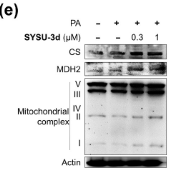Citrate synthetase Antibody - #DF13222
| Product: | Citrate synthetase Antibody |
| Catalog: | DF13222 |
| Description: | Rabbit polyclonal antibody to Citrate synthetase |
| Application: | WB IHC IF/ICC |
| Reactivity: | Human, Mouse, Rat |
| Prediction: | Pig, Zebrafish, Bovine, Horse, Sheep, Rabbit, Dog, Chicken, Xenopus |
| Mol.Wt.: | 51kDa; 52kD(Calculated). |
| Uniprot: | O75390 |
| RRID: | AB_2846241 |
Related Downloads
Protocols
Product Info
*The optimal dilutions should be determined by the end user.
*Tips:
WB: For western blot detection of denatured protein samples. IHC: For immunohistochemical detection of paraffin sections (IHC-p) or frozen sections (IHC-f) of tissue samples. IF/ICC: For immunofluorescence detection of cell samples. ELISA(peptide): For ELISA detection of antigenic peptide.
Cite Format: Affinity Biosciences Cat# DF13222, RRID:AB_2846241.
Fold/Unfold
CISY_HUMAN; Citrate synthase; Citrate synthase, mitochondrial; citrate synthetase; Cs; EC 2.3.3; EC 2.3.3.1;
Immunogens
- O75390 CISY_HUMAN:
- Protein BLAST With
- NCBI/
- ExPASy/
- Uniprot
MALLTAAARLLGTKNASCLVLAARHASASSTNLKDILADLIPKEQARIKTFRQQHGKTVVGQITVDMMYGGMRGMKGLVYETSVLDPDEGIRFRGFSIPECQKLLPKAKGGEEPLPEGLFWLLVTGHIPTEEQVSWLSKEWAKRAALPSHVVTMLDNFPTNLHPMSQLSAAVTALNSESNFARAYAQGISRTKYWELIYEDSMDLIAKLPCVAAKIYRNLYREGSGIGAIDSNLDWSHNFTNMLGYTDHQFTELTRLYLTIHSDHEGGNVSAHTSHLVGSALSDPYLSFAAAMNGLAGPLHGLANQEVLVWLTQLQKEVGKDVSDEKLRDYIWNTLNSGRVVPGYGHAVLRKTDPRYTCQREFALKHLPNDPMFKLVAQLYKIVPNVLLEQGKAKNPWPNVDAHSGVLLQYYGMTEMNYYTVLFGVSRALGVLAQLIWSRALGFPLERPKSMSTEGLMKFVDSKSG
Predictions
Score>80(red) has high confidence and is suggested to be used for WB detection. *The prediction model is mainly based on the alignment of immunogen sequences, the results are for reference only, not as the basis of quality assurance.
High(score>80) Medium(80>score>50) Low(score<50) No confidence
PTMs - O75390 As Substrate
| Site | PTM Type | Enzyme | Source |
|---|---|---|---|
| T5 | Phosphorylation | Uniprot | |
| T13 | Phosphorylation | Uniprot | |
| K43 | Acetylation | Uniprot | |
| K43 | Ubiquitination | Uniprot | |
| K76 | Acetylation | Uniprot | |
| K76 | Ubiquitination | Uniprot | |
| Y80 | Phosphorylation | Uniprot | |
| T82 | Phosphorylation | Uniprot | |
| S83 | Phosphorylation | Uniprot | |
| S97 | Phosphorylation | Uniprot | |
| C101 | S-Nitrosylation | Uniprot | |
| K103 | Acetylation | Uniprot | |
| K103 | Ubiquitination | Uniprot | |
| S190 | Phosphorylation | Uniprot | |
| K193 | Acetylation | Uniprot | |
| C211 | S-Nitrosylation | Uniprot | |
| K215 | Acetylation | Uniprot | |
| K215 | Ubiquitination | Uniprot | |
| K321 | Acetylation | Uniprot | |
| K327 | Acetylation | Uniprot | |
| K327 | Ubiquitination | Uniprot | |
| Y331 | Phosphorylation | Uniprot | |
| S338 | Phosphorylation | Uniprot | |
| K366 | Acetylation | Uniprot | |
| K366 | Ubiquitination | Uniprot | |
| K375 | Acetylation | Uniprot | |
| Y381 | Phosphorylation | Uniprot | |
| K382 | Acetylation | Uniprot | |
| K382 | Ubiquitination | Uniprot | |
| K393 | Acetylation | Uniprot | |
| K393 | Ubiquitination | Uniprot | |
| K395 | Methylation | Uniprot | |
| K450 | Acetylation | Uniprot | |
| S451 | Phosphorylation | Uniprot | |
| K459 | Acetylation | Uniprot | |
| K459 | Ubiquitination | Uniprot | |
| S463 | Phosphorylation | Uniprot |
Research Backgrounds
Methylated. Trimethylation at Lys-395 by CSKMT decreases citrate synthase activity.
Mitochondrion matrix.
Homodimer.
Belongs to the citrate synthase family.
Research Fields
· Metabolism > Carbohydrate metabolism > Citrate cycle (TCA cycle).
· Metabolism > Carbohydrate metabolism > Glyoxylate and dicarboxylate metabolism.
· Metabolism > Global and overview maps > Metabolic pathways.
· Metabolism > Global and overview maps > Carbon metabolism.
· Metabolism > Global and overview maps > 2-Oxocarboxylic acid metabolism.
· Metabolism > Global and overview maps > Biosynthesis of amino acids.
References
Application: WB Species: Human Sample: LX-2 cells
Restrictive clause
Affinity Biosciences tests all products strictly. Citations are provided as a resource for additional applications that have not been validated by Affinity Biosciences. Please choose the appropriate format for each application and consult Materials and Methods sections for additional details about the use of any product in these publications.
For Research Use Only.
Not for use in diagnostic or therapeutic procedures. Not for resale. Not for distribution without written consent. Affinity Biosciences will not be held responsible for patent infringement or other violations that may occur with the use of our products. Affinity Biosciences, Affinity Biosciences Logo and all other trademarks are the property of Affinity Biosciences LTD.

